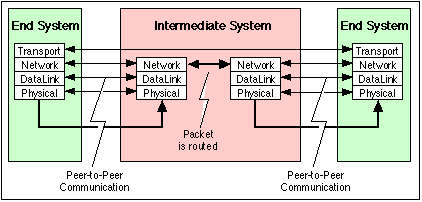
A communications network is a collection of systems (nodes) which transfer information between users attached to the networks. Two types of systems are defined within a communications network. These are:
End Systems may be directly connected, but more normally rely on the service provided by one or more Intermediate Systems. Examples of intermediate systems are bridges or LAN switches (which operate at the data link layer) and router or network switches (which operate at the network layer).
The communications process between end systems and intermediate systems is usually defined in terms of a reference stack. Intermediate systems handle only protocol information at and below the network layer, whereas end systems use protocols at all the layers of the reference model.

Two End Systems connected by an Intermediate System (in this case a router) The figure shows various protocol layers